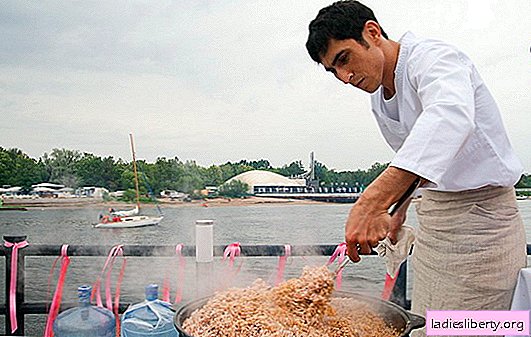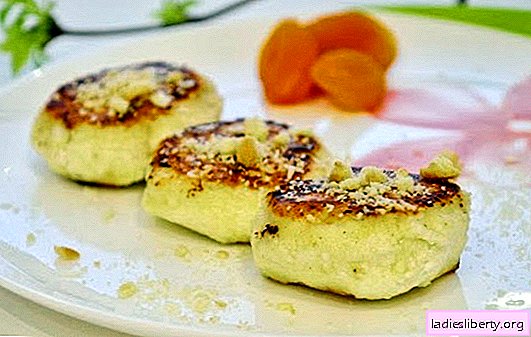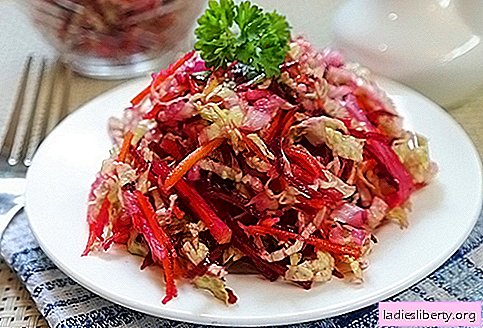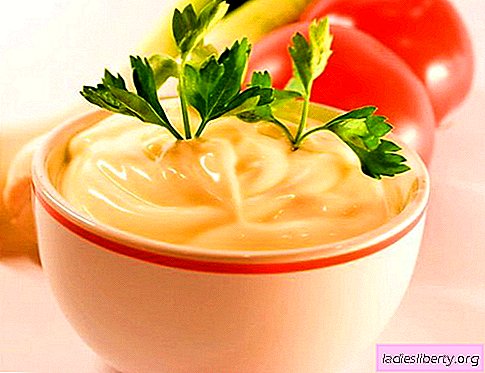
What recipes of pilaf you will not meet on open spaces of "world wide web"!
This is pilaf with Georgian herbs, but in the best Uzbek traditions, performed by Estonian chefs, and Uzbek pilaf with pork (!) From unknown authors who are not only familiar with Uzbek traditions, but also with Muslim canons in principle .
Pilaf with fish, with vegetables and dried fruits, melt with quince or fresh tomatoes, with beans or mushrooms: everything is what your heart desires.
But we must admit that if the technology of cooking rice is followed, then any of these dishes has the right to be called pilaf, and it is not customary to argue about tastes.
Another fact is interesting, but it is worth paying attention to - dishes for the preparation of one of the most ancient dishes on the planet.
After all, it is clear that at the dawn of civilization there were no crock-pots, microwave ovens, or other advanced household appliances. There was a time when even bonfire fire and roast meat on a spit was considered an achievement of mankind. The most interesting thing is that until now people have not abandoned the habit of gathering around the fire and baking potatoes, frying kebabs, boiling fish soup right on the lake or preparing pilaf in a large cauldron. Why?
Just compare the pilaf cooked in the old way and the one that "cooked it yourself" in the slow cooker, and to the taste of the fire no real gourmet can remain indifferent.
Pilaf in a cauldron at the stake - basic technological principles
Whatever foods are part of pilaf, one of its most important ingredients, boiled friable rice, always remains unchanged.
There are two main ways to cook pilaf. The first way involves phasing the ingredients into the cauldron. First, oil is heated, stewed, fried or sautéed, then meat, fish or vegetables, mushrooms, then rice is added and covered with broth or water, the dish is cooked until cooked. This method is more common in Central Asian cuisine.
The second cooking option is more ancient, and originates somewhere at the origins of the formation of the Persian Kingdom, and maybe even even earlier. But the second method, which provides for the separate preparation of the constituent components of pilaf with their subsequent combination in a cauldron or even directly in a dish, is also quite common in modern world culinary.
Last important question: why is it better to cook pilaf in a cauldron? The answer is simple and obvious. Thick walls and the bottom of cast-iron dishes warm up well and hold the desired temperature until the pilaf is cooked. In Iran and some other countries of the Middle East, the tradition of making cauldrons from copper is still preserved. It is believed that copper utensils have a particularly beneficial effect on the food prepared in it, and this opinion is reasonable from a medical point of view.
So, for example, it is known that this element plays an important role in hematopoiesis, enzymatic processes. In contact with food, copper dishes under the influence of high temperature reacts and enriches it with useful properties. Agree that with all its modern advantages, a multicook made of stainless steel or other alloys does not have such an advantage.
As for the choice between a stove, an oven, an oven or an open fire (bonfire), it is rather a question related to the category of convenience of cooking. Of course, food cooked in the confined space of the oven retains more useful properties than on the stove, due to the fact that vitamins are evaporated from it into the open space to a lesser extent, and the limited access of air oxidizes products to a lesser extent.
Cooking at the stake is a tribute to an ancient tradition gathering a clan around a fire, which has almost magical power and attracts the eye of a person. Although, on the other hand, how else can one prepare a wedding pilaf, for example, in some village or village where everyone comes to a noble and obligatory celebration party, from small to large? So you have to choose a larger cauldron, so that there is enough for everyone. But in these cases, as a rule, only men cook pilaf, because the cauldron has a very impressive size, and you need to be able to make a fire correctly.
First, the fire is allowed to burn out. If you cook pilaf at the stake, then wait for the wood to glow with heat, not letting out flames. For cooking pilaf, the heat should be enough for an hour and a half. But, by the way, here time is also calculated depending on the volume of the cauldron, which is hung from a pen or mounted on stones or a grate over hot coals. The beauty of pilaf, like any food cooked at the stake, is its special, slightly smoked aroma. The last nuance of cooking pilaf in a cauldron at the stake is the choice of firewood. It is necessary to give preference to hardwood of fruit trees, so that the smell of pilaf was even more inimitable.
Any recipe for pilaf cooked at the stake will have a unique and completely new taste, different from that prepared in the same way on a regular stove, and even more so in a slow cooker or microwave.
Recipe 1. Pilaf in a cauldron with veal and mushrooms
Ingredients:
Meat (flesh), nonfat 700 g
Ceps 1.4 kg
Pepper, ground and peas (allspice and black)
Carrot 500 g
Bay leaves 3-4 pcs.
Rice, long unpolished 600 g
Onion 0.5 kg
Dill
Butter, ghee and olive (for frying)
Turmeric
Salt
Cooking:
Prepare vegetables, mushrooms and meat by washing them. Remove the veal from the veal, cut into medium-sized pieces. Sort the mushrooms, boil and drain the water. The broth after boiling porcini mushrooms can be used to prepare any dishes, but the mushrooms must be previously carefully selected and washed. Cut carrots and onions into strips.
Heat the olive oil in a cauldron and pass the carrots and onions in it. Put the meat when the onion becomes clear. Season with spices and lay the mushrooms. Add the melted butter to the mushrooms. Let the meat and mushrooms brown, put the prepared rice on them and cover all the ingredients with mushroom broth, in which first add salt, turmeric, bay leaves and pepper (bring to a boil, and then pour into the pilaf). Cover the cauldron with a lid and simmer until cooked. Put chopped dill greens 2-3 minutes before the rice is cooked. If desired, you can add a few cloves of garlic, cut into thin plastics.
Recipe 2. Festive pilaf in a cauldron at the stake, in Persian
Ingredients:
Pistachios 30 g
Almond shavings 60 g
Cashew 70 g
Dried Barberry 50 g
Onion 200 g
Butter, ghee 160 g
Orange 400 g
Tea rose (petals) 10 g
Zira 20 g
Saffron 2 g
Basmanti 500 g
Raisins dark and light - 100 g each
Carrot 0.5 kg
Turmeric 30 g
Sugar 200 g
Water 1.7 L
Salt
Cooking:
Wash the rice and fill it with cold water. Fry the nuts and make medium-sized crumbs. Wash the oranges and peel, cutting them into 4 or 8 slices. Peel the inside of the orange peel from the white peel as much as possible, then cut the peel with a thin zest straw. With the same straw, chop the peeled carrots and chop the onions. Wash the raisins. Boil water (200-300 ml) and add saffron, salt and turmeric to it. In the rest of the water, put sugar, chopped orange peel and carrots, cook until sugar dissolves and let it stand under the lid for about fifteen minutes.
Melt the butter in a cauldron, throw onion, zira, barberry and raisins into it. Stew on low heat for up to five minutes, add carrots with orange peels, prepared rice and pour hot water. After the rice is cooked, put the pilaf on the dish, sprinkle it on top with the chopped tea rose petals and cooked nut crumbs. Pilaf is served hot.
Recipe 3. Pilaf in a cauldron with beer - German cuisine
German cooks also offer their own, original for oriental cuisine, vision of pilaf. That is, pilaf with pork can often be found in resort towns. Moreover, often Muslim cooks cook such pilaf, but it is customary to combine pork with beer only for making barbecue. In Germany, these products are an integral part of the national cuisine. We can say with confidence that pork in beer is very tasty.
Ingredients:
Pork neck 1.0 kg
Steamed rice 400 g
Onions 300 g
Garlic 50 g
Lemon zest (fresh) 20-30 g
Pomegranate 1 pc.
Hot red pepper, fresh to taste
Thyme 20 g
Beer, light 1.5 l
Parsley 120 g
Ground pepper (mixture)
Salt
Refined oil (for frying) 50-70 g
Cooking:
Rice and rinse in water to soak while preparing the rest of the ingredients. After washing the meat, put in the marinade of beer, pepper, garlic, salt and thyme. Soak for a couple of hours. Hot peppers previously free from seeds and chop finely. Add it carefully so as not to overdo it.
Preheat a cast-iron cauldron or goslitsyatu. Pour in the oil and, as soon as it boils, put the pieces of meat, but so far without marinade. It is advisable to dry the meat a little with a napkin, so that when frying it becomes faster covered with a blush. Add the onion and lightly darken it, after which you can season the meat with spices and lemon zest. Put the rice on top and pour it with the marinade in which the meat was lying. If the marinade is not enough, you can add more beer or hot water to cover the entire rice with liquid. Cover and simmer until cooked. Add chopped dill and parsley. When serving, sprinkle the dish with fresh pomegranate seeds.
Recipe 4. Festive pilaf in a cauldron on a bonfire with lamb and dried fruits in the Georgian style
Ingredients:
Lamb 2.4 kg
Onion 1.2 kg
Rice, long 1.5 kg
Carrot 1.0 kg
Prunes 200 g
Dried apricots 400 g
Garlic 300 g
Raisins 250 g
Refined Oil 150 ml
A mixture of Georgian spices (hops-suneli, uzo-suneli)
Cooking:
Prepare the rice by soaking it in water. Remove the film on the meat, wash, dry and divide it into 12 portions. Pour dried fruit over hot water, cut dried apricots and prunes with long bars. Cut carrots and onions into strips. Peel the garlic from the top layer of the husk, wash and cut the rhizomes.
In a cauldron, heat the oil to smoke. Cut two medium carrots and two onions into four parts and put in boiling oil, fry them until brownish. Remove the vegetables with a slotted spoon and lay the fried meat. When it is browned, add onions and carrots, cut into strips. After 10 minutes, add spicy herbs, dried fruits and hot water to cover the meat. Simmer for 20 minutes under the lid. After opening the lid, put rice on the vegetables with a thin layer. Put whole heads of garlic on top of the rice, add boiling water to cover the rice with liquid. Make a few holes with a spoon so that the liquid from the bottom evaporates freely. Do not mix the layers. Try zirvak to taste and adjust it, salt. Cover the pilaf and simmer until rice is cooked.
Recipe 5. Quick pilaf in a cauldron with sausage, broccoli and cauliflower
Ingredients:
Cooked smoked sausage, with lard 900 g
Onion 0.6 kg
Wild rice 400 g
Broccoli 250 g
Cauliflower 300 g
Adjika, Georgian 100 g
Parsley 100
Broth (meat or vegetable)
Carrot 600 g
Butter, melted and vegetable (for frying) 50 g each
Cooking:
Prepare the rice by soaking it in water. Cut onion, sausage and carrots into half rings. Inflorescences of broccoli and cauliflower cut lengthwise, in half. Heat the oil in a cauldron to a boil and alternately dip the carrots, sausage, chopped cabbage inflorescences, onions in it. Put rice cooked until half cooked in a cauldron, distributing it evenly over the entire surface, pour in the broth to cover the contents of the cauldron, add adjika and simmer the pilaf under a closed lid. Five minutes before cooking, put chopped parsley in a cauldron.
Recipe 6. Pilaf in a cauldron at the stake - Estonian cuisine
In their own way and quite original, they imagine the process of cooking pilaf cooks in Estonia. With cooking technology similar to Asian and Middle Eastern, pilaf in Estonian has a peculiar addition of citruses and tomatoes. Even adding instead of the traditional oriental spices of the Mediterranean favorite, oregano, creates some intrigue. But, nevertheless, this dish is also pilaf, given that it has a common component for all types of pilaf - boiled friable rice.
Ingredients:
Refined Oil 150 ml
Lamb (young meat) 1.2 kg
Long steamed rice 500 g
Black pepper 40 g
Onion 400 g
Zest and lemon juice 1 pc.
Tomato puree 150 g
Oregano 50 g
Salt
Chopped parsley 70 g
Chicken Broth 1.2 L
Cooking:
Pour the washed rice with cold water, soak for about two hours while preparing the rest of the ingredients. Free the meat from the films and cut into medium-sized cubes.
In hot oil, fry the lamb until a crust is obtained, add onions, sprinkle with salt and pepper. Continue frying until the onions are clear. Do not mix: the meat should remain below. Dissolve tomato puree in hot chicken stock, add oregano, zest and juice. Pour the mixture into a cauldron with meat and simmer slowly for about half an hour, covering the dishes with a lid. Put the prepared rice on a layer of onion, if necessary, add hot broth on top so that the rice is covered with 2 cm liquid. When the broth has boiled almost completely, remove the cauldron from the heat and let it stand for a while to absorb the remaining broth. Lay the pilaf in layers, in reverse order, so that the meat is on top. Sprinkle it with chopped parsley.
Recipe 7. Pilaf in a cauldron of chicken with quince - Arabic cuisine
Useful advice and at the same time a fundamental difference in the preparation of pilaf in Arabic and Central Asian cuisine: the first in the heated oil during the preparation of pilaf is not dipped onions, but carrots. “Plovovary” of the Middle East believe that carrots cleanse oil from harmful substances, which, as you know, forms carcinogens during frying. With this method of cooking pilaf, carrots containing carotenoids, oil-soluble and identical to the natural dye, give the rice a beautiful bright yellow color, decorating the dish. The high sugar content in the root crop creates a pleasant caramel taste. By the way, if it happens that during the preparation of the dish it turned out that the carrots are not sweet or juicy enough, add a little sugar when it is cooked: it contributes to the release of carrot juice and caramelization when heated.
Ingredients:
1.5 kg chicken thighs
Rice 600 g
Quince 1.0 kg (Net)
Onion 0.5 kg
Refined Oil 180 ml
Caraway
Pepper
Carrot 700 g
Salt
Cooking:
Wash the treated chicken thighs and remove excess water. In Arabian cuisine, Indian basmati rice is preferred for pilaf. You can replace it with other varieties of thin long-grain, white rice. Rinse the cereals several times in cold water and soak in a bowl with very cold water, preferably at least an hour.
In a cauldron, heat the oil until smoke begins and throw 200 g of coarsely chopped carrots into it. Fry until dark, remove slices with a slotted spoon, and put the remaining carrots in sliced butter. Then, after five minutes, put the onion, sliced in rings. As soon as the onion becomes slightly transparent, put chicken meat on the bone on it, season with spices, lightly fry and add hot water to cover the meat, cover the cauldron with a lid.Stew the meat for about half an hour, covering it with peeled quince slices. Put rice on the meat. If necessary, add a little more water and bring the rice to the finished consistency.
Remove the cauldron from the heat and let the pilaf stand under the closed lid so that the rice absorbs the remaining moisture. Pilaf is laid out in a traditional way on a dish: first - rice; onions, carrots and quinces are on it, and on top are pieces of meat.
Pilaf in a cauldron - useful tips and tricks
When cooking rice in pilaf, the grains must remain quite solid, because they swell and reach the desired consistency, when the pilaf is removed from the fire, covered with a lid: rice at this time absorbs the rest of the water. Do not forget that pilaf should be crumbly, without liquid.
Carrots in pilaf, as well as other additional ingredients, should be noticeable after cooking, as a decoration of the dish. Therefore, cut it not too finely and beautifully. The same can be said about meat. Although the meat in the pilaf can be both small and large, but it should be clearly visible.











